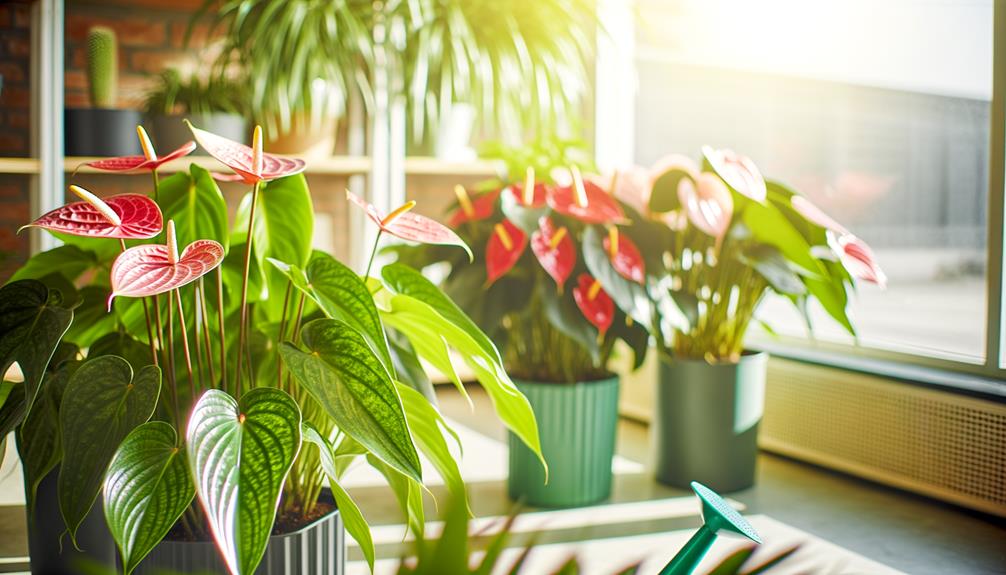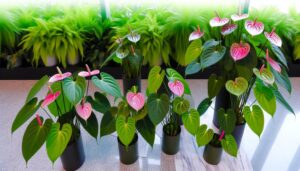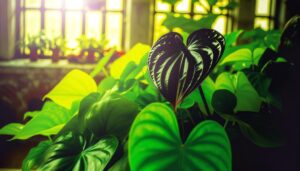Caring for Anthurium and Red Aglaonema: A Beginner's Guide
To care for Anthurium and Red Aglaonema, place them near an east-facing window for bright, indirect light. Water when the top inch of soil feels dry, and monitor for overwatering signs like yellowing leaves.
Use a well-draining soil mix containing peat moss, perlite, and pine bark. Maintain a temperature range of 65°F to 80°F and high humidity (60-80%).
Fertilize every 4-6 weeks with a balanced, water-soluble fertilizer. Watch for common issues like fungal infections or pests such as aphids.
Effective care practices encompass more nuanced techniques to ensure peak plant health.

Key Takeaways
- Place Anthurium and Red Aglaonema in bright, indirect light to prevent photodamage.
- Water when the top inch of soil is dry to avoid overwatering.
- Use a well-draining soil mix with perlite and orchid bark.
- Maintain humidity levels above 60% for Anthurium and above 50% for Red Aglaonema.
- Fertilize every 4-6 weeks during the growing season with a balanced, diluted fertilizer.
Light Requirements
Both Anthurium and Red Aglaonema thrive in bright, indirect light but can tolerate lower light conditions. Position them near an east-facing window where they'll receive diffused sunlight. Avoid direct sunlight, which can cause photodamage, including leaf scorch and chlorosis.
If natural light is insufficient, use full-spectrum grow lights. Maintain a light intensity of approximately 10,000 to 20,000 lux for best photosynthesis. Monitor leaf coloration; pale leaves may indicate excess light, while dark, elongated leaves suggest inadequate light.
Rotate your plants every few weeks to ensure consistent light exposure and balanced growth. By carefully adjusting their light environment, you'll promote robust foliage and vibrant blooms, creating a lush, flourishing indoor oasis.
Watering Schedule
To maintain peak growth, establish a consistent watering frequency based on the plant's specific needs. Monitor for signs of overwatering such as leaf yellowing and root rot.
Implement best watering practices by ensuring soil moisture levels align with the plant's natural habitat conditions.
Optimal Watering Frequency
Determining the most suitable watering frequency for Anthurium and Red Aglaonema hinges on monitoring the moisture levels in the soil and understanding each plant's specific hydration needs. Use your finger or a moisture meter to assess soil dampness. Anthuriums prefer slightly damp soil, while Red Aglaonemas thrive when the top inch is dry before the next watering.
Here's a quick reference table:
| Plant Type | Soil Moisture Preference | Recommended Frequency |
|---|---|---|
| Anthurium | Slightly damp | Every 1-2 weeks |
| Red Aglaonema | Top inch dry | Every 1-2 weeks |
| Both in Winter | Less frequent | Every 2-3 weeks |
Always adjust based on ambient humidity and temperature. Remember, consistent monitoring and adjusting are key to maintaining their best health.
Signs of Overwatering
Detecting signs of overwatering in Anthurium and Red Aglaonema is essential to prevent root rot and other moisture-related issues.
First, examine the leaves for chlorosis, a condition where leaves turn yellow due to excess moisture disrupting nutrient absorption. Check for edema, where cells swell and burst, leading to blister-like bumps on leaves.
Inspect the soil for anaerobic conditions—if it smells sour or musty, it's likely too wet. Feel the soil; it should be slightly moist, not soggy.
Roots turning black or mushy indicate root rot, a critical sign of overwatering.
Ultimately, monitor for fungal growth on the soil surface, often a result of excessive moisture. Addressing these signs early will safeguard your plants' health.
Best Watering Practices
Establishing an effective watering schedule for Anthurium and Red Aglaonema involves understanding their unique moisture needs and the environmental factors that influence soil hydration. Follow these detailed instructions to maintain ideal hydration:
- Evaluate Soil Moisture: Insert your finger about an inch into the soil. If it's dry, it's time to water. Moist soil indicates sufficient hydration.
- Water Quality: Use filtered, room-temperature water. Tap water's chlorine and fluoride can harm plant roots.
- Watering Frequency: Water Anthurium every 1-2 weeks and Red Aglaonema every 2-3 weeks, adjusting for humidity and light conditions.
- Drainage: Make sure pots have drainage holes to prevent waterlogging, which can lead to root rot.
Adhering to these steps will keep your plants thriving and vibrant.
Ideal Soil Mix
For best growth of Anthurium and Red Aglaonema, make sure your soil mix provides proper drainage and is nutrient-rich.
You'll want to incorporate components like perlite and orchid bark to improve aeration and prevent waterlogging.
Additionally, integrate organic matter such as compost to supply necessary nutrients.
Proper Drainage Essentials
Achieving best drainage for Anthurium and Red Aglaonema requires a well-aerated soil mix composed of equal parts peat moss, perlite, and pine bark. This combination guarantees ideal moisture retention while preventing waterlogging—a crucial aspect for these tropical plants.
Here's a step-by-step guide to crafting the ideal mix:
- Peat Moss: Retains moisture and provides organic matter, improving soil structure.
- Perlite: Include to boost aeration and drainage, avoiding root rot.
- Pine Bark: Contributes bulk and natural acidity, maintaining pH levels and supporting root health.
- Mixing: Blend these components evenly in a large container, ensuring complete integration before potting your plants.
Nutrient-Rich Ingredients
Now that you've established a proper drainage system, let's focus on incorporating nutrient-rich ingredients to enhance the soil mix for Anthurium and Red Aglaonema.
Start with a base of peat moss, which retains moisture while providing aeration. Add perlite for improved drainage and to prevent root rot. Incorporate pine bark to enhance texture and facilitate nutrient absorption.
To achieve a balanced pH, mix in a small amount of horticultural charcoal. Finally, enrich the soil with a slow-release fertilizer high in phosphorus for strong root development.
This precise blend offers your plants an ideal environment, promoting vigorous growth and vibrant foliage. Now, your Anthurium and Red Aglaonema are ready to thrive in their nutrient-rich, well-draining habitat.
Temperature and Humidity
Maintaining ideal temperature and humidity levels is essential for the healthy growth of Anthurium and Red Aglaonema. You'll want to guarantee these tropical plants thrive in conditions that mimic their native environment.
Here's what you need to do:
- Temperature: Keep the ambient temperature between 65°F and 80°F (18°C to 27°C). Avoid cold drafts and sudden temperature changes, which can stress the plants.
- Humidity: Maintain relative humidity levels between 60% and 80%. Use a hygrometer to monitor and a humidifier if necessary.
- Ventilation: Ensure sufficient air circulation to prevent fungal growth, but avoid direct airflow from fans or air conditioners.
- Placement: Position them away from heating vents and windows with intense sunlight to prevent leaf scorch.
Fertilizing Tips
For best growth, fertilize your Anthurium and Red Aglaonema every 4-6 weeks during the growing season with a balanced, water-soluble fertilizer diluted to half strength. Make sure that you apply the fertilizer evenly to the soil to prevent nutrient imbalances.
Here's a quick reference table for fertilizing specifics:
| Plant Type | Fertilizer Ratio |
|---|---|
| Anthurium | 20-20-20 NPK |
| Red Aglaonema | 10-10-10 NPK |
| Fertilizing Interval | Every 4-6 weeks |
| Dilution Rate | 50% of recommended dose |
Regular feeding promotes robust growth and vibrant foliage. Be careful to avoid over-fertilization, which can lead to nutrient toxicity and root damage. After applying, water thoroughly to help the fertilizer penetrate the root zone, ensuring the best nutrient uptake.
Common Issues
While proper fertilization promotes healthy growth, it's equally important to recognize and address common issues that can impact your Anthurium and Red Aglaonema.
By identifying symptoms early and taking corrective measures, you can guarantee robust plant health.
- Yellowing Leaves: Often a sign of excessive watering or insufficient light. Check soil moisture levels and adjust your watering schedule accordingly.
- Brown Leaf Tips: Typically caused by low humidity or excessive fertilization. Increase ambient humidity and reduce fertilizer application.
- Pest Infestation: Look for aphids, spider mites, and mealybugs. Use insecticidal soap or neem oil to treat affected plants.
- Root Rot: Results from poor drainage or overwatering. Ensure pots have ample drainage holes and use a well-draining soil mix.
Conclusion
In your journey to nurture anthurium and red aglaonema, imagine their glossy leaves and vibrant colors thriving under just the right conditions.
With ample indirect light, a consistent watering schedule, a well-draining soil mix, and ideal temperature and humidity, you'll create a mini tropical oasis.
Don't forget to fertilize regularly and stay vigilant against common pests.
Your dedication will transform your space into a lush, green sanctuary teeming with botanical splendor.
Embrace the science; watch nature flourish.






